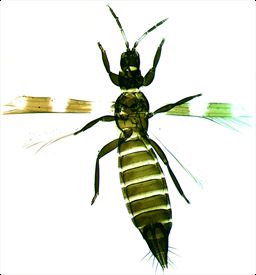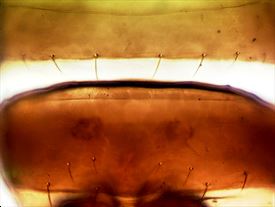Distinguishing features
Both sexes fully winged. Female brown including legs; antennal segment III yellow with extreme apex brown, IV–IX brown; fore wing broad, dark at extreme base but clavus largely pale, with two transverse dark bands, median pale band shorter than distal dark band, apex clear with ring vein pale. Head with postocular region as long as eye length; maxillary palp 3-segmented. Antennae 9-segmented; segment III long and slender with linear sensorium scarcely 0.3 as long as segment, IV with sensorium almost 0.5 as long as segment and curved distally, without internal markings. Mesonotum with no accessory setae medially. Metanotal reticles without internal markings. Abdominal tergite I with faint transverse lines anteromedially; trichobothria on X no larger than base of major setae on X. Sternites with 4 pairs of marginal setae, discal setae not developed; sternite VII accessory setae arising well in front of margin.
Male similar to female but smaller; antennal segment III almost fuscous rather than yellow, but abdominal segments III–V sometimes paler than II and VI. Abdominal tergite I with two longitudinal ridges; IV–V each with pair of irregular tubercles; IX with paired bifurcate claspers postero-laterally, postero-angular pair of setae longer than claspers. Sternites without discal setae.
Related species
The genus Aeolothrips is essentially Holarctic, and currently includes about 105 species. However, A. fasciatus can be recognised unequivocally only in the male sex, in which the postero-angular setae on tergite IX are longer than the claspers. Females are closely similar to A. intermedius, a very common species in Europe. However, A. intermedius has the third antennal segment less slender than in A. fasciatus and more extensively brown toward the apex. A. fasciatipennis Blanchard from Chile is probably a parthenogenetic strain of A. fasciatus, and apparently identical females are known also from California. A. fasciatus is recorded from Tasmania, and also from New Zealand, on the basis of males and females. It is readily distinguished from Desmothrips species by the very different banding pattern on the fore wings with the wing apex pale.
Biological data
Breeding in the flowers of plants in various families, but with no recorded specificity, and presumably acting also as a facultative predator of other thrips.
Distribution data
Described from Europe, this species has been recorded in various parts of the world. However, records based only on females may not be correct, because A. fasciatus can be distinguished unequivocally only in the male sex. Males of this species have been studied from Finland, Denmark, Germany, Slovakia, Azores, Hokkaido, New Zealand and Tasmania. Females have been seen from many sites across the full length of New Zealand.
Family name
AEOLOTHRIPIDAE
Species name
Aeolothrips fasciatus (Linneaeus)
Original name and synonyms
Thrips fasciatus Linneaeus, 1758: 457
Coleothrips trifasciatus Fitch, 1855: 386
Aeolothrips fasciatus f.atricornis Maltbaek, 1927: 14
Aeolothrips fasciatus justiciae Post, 1961: 137
References
Mound LA, Tree DC & Paris D (2012) OzThrips – Thysanoptera in Australia. http://www.ozthrips.org/
http://www.ozthrips.org/terebrantia/aeolothripidae/aeolothrips-fasciatus/
Mound LA & Walker AK (1982) Terebrantia (Insecta: Thysanoptera). Fauna of New Zealand 1: 1–113.




